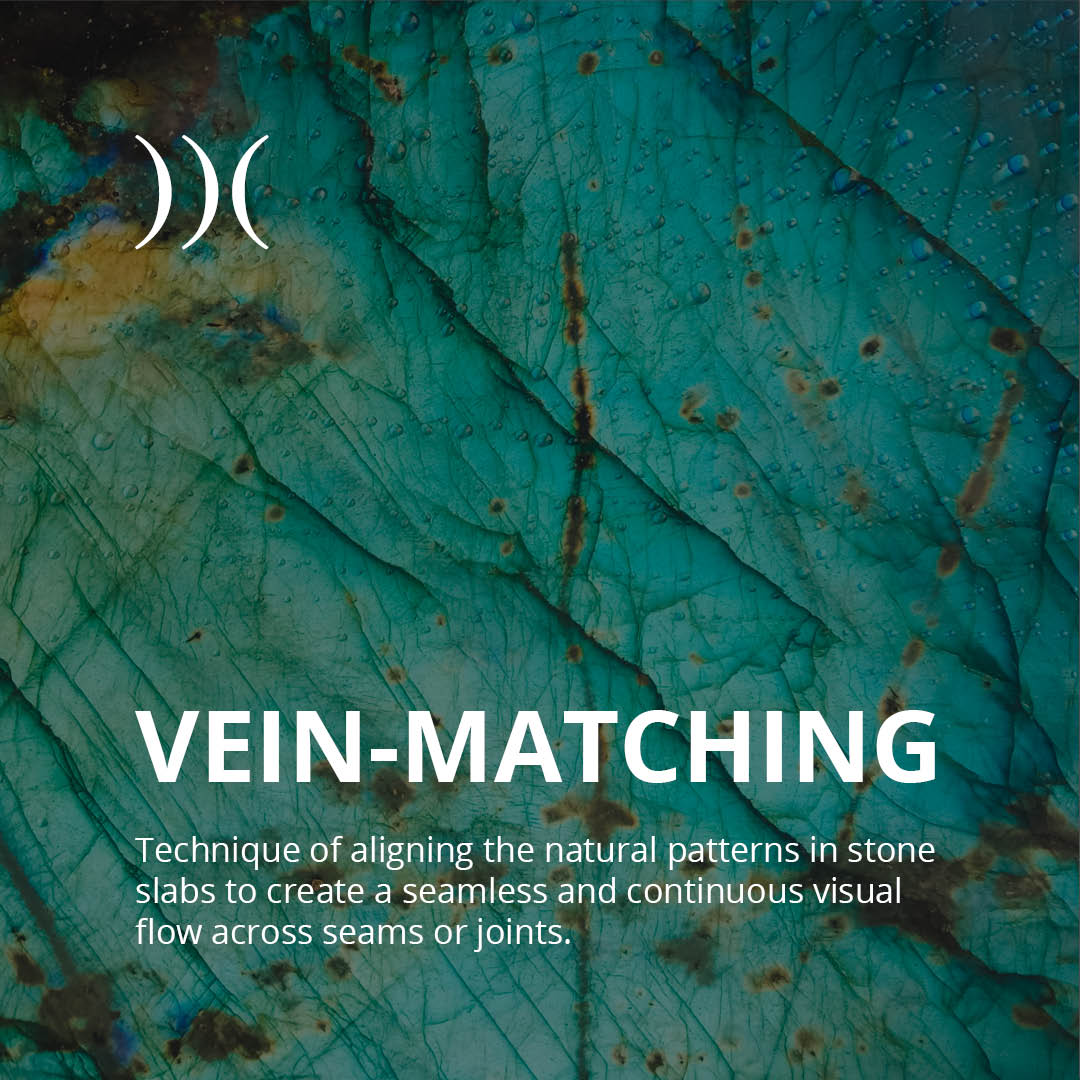
Craftsmanship and harmony: these are the details that transform a marble, granite, or quartz countertop into an authentic stylistic signature in bathroom and kitchen design. But how can you best enhance the natural features of stone and achieve a flawless aesthetic result? Thanks to vein-matching, you can create the effect you want with a few simple precautions.
Read this article to find out what vein-matching is and why it is essential for enhancing the elegance and uniqueness of your countertop.
What is Vein-Matching?
Have you ever heard of vein-matching? It is a technique used to align the natural veining of marble and other materials at cuts and joints. The goal is to create an effect of visual continuity. The result is a surface with a high-quality aesthetic finish.
This type of processing should not be confused with book match, in which the slabs are cut and opened “like a book” to obtain a mirrored, symmetrical effect.
Why does Vein-Matching Enhance your Bathroom or Kitchen Design?
If you are wondering why you should choose vein-matching for your bathroom or kitchen countertops, keep reading.
Firstly, you need to consider the aesthetic effect you are looking for. The joints between slabs become invisible and the veins extend seamlessly, as if the surface had been carved from a single slab. This way, you get an elegant and harmonious piece of furniture.
When designing your kitchen or bathroom, every detail matters. Vein-matching contributes to the creation of customized projects with high decorative value. The final result is more striking and refined, for a sophisticated and innovative design.
However, the benefits of this technique are not only aesthetic, but also functional. In fact, the alignment of the veining produces a uniform surface that can be easily integrated with other materials and furniture.
Furthermore, given the uniqueness of each marble or quartzite slab, vein-matching allows for a higher level of customization, depending on the environment. In this way, you increase the perceived value of the surface, clearly communicating the exclusivity of the project.
Vein-Matching and Book Match: Differences
Ones of the most common doubts concerns the difference between vein-matching and book match. In fact:
- Vein-matching is a technique in which the veining is aligned seamlessly. It is the ideal solution for bathroom countertops with matching sinks and shower cladding, or for kitchen countertops and backsplashes.
- Book match, on the other hand, is used when the cut of a block generates two mirror-image slabs (like the pages of a book). The marble veins are reflected, creating symmetrical and artistic patterns: a spectacular effect, perfect for decorative walls, but less practical and versatile compared to vein-matching.
How to Create a Countertop Using Vein-Matching
To create bathroom or kitchen countertops, a series of steps are necessary to enhance the raw materials and their characteristics.
Here are the main stages that take a project from design to finished product.
1 – The Choice of Slabs
First of all, the slabs of marble or other veined natural stones must be chosen.
To achieve the desired effect, the following must be taken into consideration:
- the quality of the veining;
- the color of the slab;
- the pattern;
- the perfect match between the slabs to be worked together.
This is a truly creative act, during which the operator can already imagine the final result based on the raw potential of the material.
2 – Cutting the Slabs
Once selected, the slabs are cut. Currently, thanks to the use of latest generation CNC machines, clean cuts can be performed with millimetric precision, without damaging the aesthetics of the slab. This stage is crucial for the creation of vein-matching, a technique based on cutting accuracy. The operator must therefore be able to program the machinery so that it follows the curved and irregular lines of the veining, ensuring the success of the project.
3 – Nesting
The cut pieces are arranged and aligned. The nesting phase is essential for vein-matching, as operators arrange the various elements to achieve the desired continuity. To perform this operation, specialized software is used, allowing the pieces to be visualized in 3D and simulating the alignment of the veining. This way, corrections can be made before completing the physical processing of the slab.
4 – Polishing
To give the surface brightness and depth, polishing is carried out. The colors of the veining become more vivid, and the alignment is enhanced, creating a reflective and artistic effect.
A high-quality bathroom or kitchen countertop is the result of the combination of technology, high-performance CNC machines, and specialized expertise. Knowledge of the material, its veining, and the ability to predict the final result are all part of the technical skills of industry professionals. Craftsmanship merges with modern stone processing techniques to create surfaces of the highest quality and timeless appeal.
Why Choose Vein-Matching for your Interior Design Projects?
Choosing vein-matching for your kitchen or bathroom projects means opting for a refined and minimalist solution. Few elements can define a space dominated by smooth surfaces and neutral colors, where the veining of marble or natural stone becomes the absolute protagonist.
In an open-space kitchen, a countertop featuring vein-matching creates stylistic coherence between the different areas of the room. Similarly, a countertop can transform a bathroom into a luxurious yet welcoming space.
Every project created using the vein-matching technique acquires a distinctive appearance. Each slab tells a unique story, and this is precisely its added value. The aesthetic beauty lies in the characteristics of the material, which transform every space into a true work of art.









